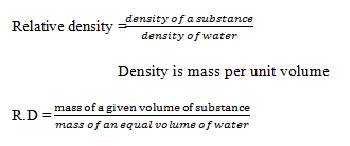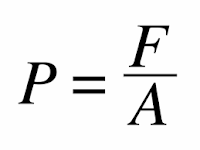Flotation
Flotation
When an object is placed on the surface of a liquid if the object float on the
surface this condition is called flotation.
Buoyancy
The property of the liquid which makes object float on its surface. this
property is called by buoyancy.
Density
It is defined as mass per unit volume.
Formula
Unit:
It has unit kilogram per cubic meters ( Kg / m3 ).
Relative density (RD)
It is defined as the ratio of the density of the liquid to the density of the
water at 4 degrees Celsius.
Formula
Relative density= density of the liquid /density of the water at 4°C
Relative density is constant. it has no unit.
At 4 degrees Celsius water has a maximum density that's why we take the water
at 4 degrees Celsius.
Pressure
Pressure is defined as a force acting per unit area.
Formula
Unit newton per square meters (N/m2) or pascal(Pa)
Define one Pascal
Pressure is said to be one Pascal when a force of 1 Newton is applied on a
surface whose area is 1 meter square.
Thrust
It is a type of force which is applied by the liquid on any of the objects.
The unit of thrust is the same as that of the force newton (N).
Upthrust
When an object is placed on a surface of the liquid. A liquid will apply the
force on the object in an upward direction. This is called Upthrust.
it's also known as the Buoyant force.
Archimedes Principle
According to Archimedes, when a body is immersed fully or partially in a
fluid. It experiences an upward force that is equal to the weight of the
liquid displaced by it.
Laws of floatation
When a body is immersed in water or fluid
Then there are two forces are acting on it.
1. Buoyant force or upthrust (Vertically upward)
2. Force due to its weight (vertically downward.)
Conditions for the flotation
1.
When a buoyant force (B) = weight of the body (W)
Then object will float and stationary.
2.
Buoyant Force (B) < the weight of the body (W)
Buoyant Force is less than the weight of the body
Then the object will move downward and sink.
3.
Buoyant Force (B) > the weight of the body (W)
Buoyant Force is more than the weight of the body
Then the object moves upward and floats on the surface.
Conditions for the floatation in terms of density
Derivation
Relative density
It is the ratio density of a substance to the density of the liquid.
Formula
It has no unit because it is the ratio.
Meaning of Relative density
If the value of RD is less than 1 body will float otherwise the body will
sink.
May be These also help you.
Basic Science Chapterwise Solutions Class 6
- Chapter 1. Matter and Its Nature
- Chapter 2. Food
- Chapter 3. Classification of Materials
- Chapter 4. Clothes and Fibres
- Chapter 5. Separation of Mixtures
- Chapter 6. A Study of Changes
- Chapter 7. The Living and the Nonliving
- Chapter 8. Habitat and Adaptation
- Chapter 9. About Flowering Plants
- Chapter 10. Movements of the Body
- Chapter 11. Measurement
- Chapter 12. Motion
- Chapter 13. Light
- Chapter 14. Electric Circuits
- Chapter 15. Magnetism
- Chapter 16. Water
- Chapter 17. Air—The Breath of Life
- Chapter 18. Waste











0 Comments
Please don't give write any spam link.